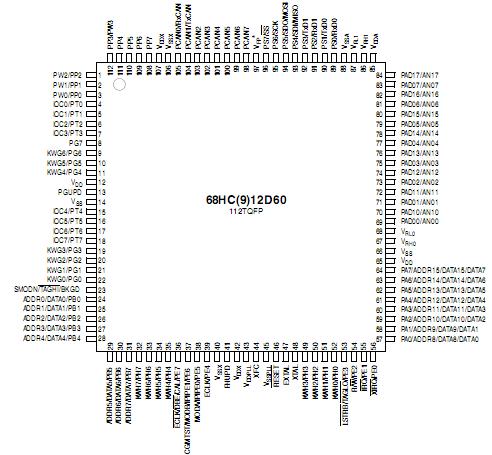Features: • 16-bit CPU12
Upward compatible with M68HC11 instruction set
Interrupt stacking and programmer's model identical to
M68HC11
20-bit ALU
Instruction queue
Enhanced indexed addressing
• Multiplexed bus
Single chip or expanded
16 address/16 data wide or 16 address/8 data narrow mode
• Two 8-bit ports with key wake-up interrupt (2 pins only are
available on 80QFP) and one I
2C start bit detector (112TQFP
only)
•Memory
60K byte flash EEPROM, made of a 28K module and a 32K
module with 8K bytes protected BOOT section in each module
(68HC912D60)
60K byte ROM (68HC12D60)
1K byte EEPROM
2K byte RAM
• Analog-to-digital converters
2 x 8-channels, 10-bit resolution in 112TQFP
1 x 8-channels, 8-bit resolution in 80QFP
• 1M bit per second, CAN 2.0 A, B software compatible module
Two receive and three transmit buffers
Flexible identifier filter programmable as 2 x 32 bit, 4 x 16 bit or
8x8bit
Four separate interrupt channels for Rx, Tx, error and wake-up
Low-pass filter wake-up function
In 80QFP, only TxCAN and RxCAN pins are available
Loop-back for self test operation
Programmable link to a timer input capture channel, for time-
stamping and network synchronization.
• Enhanced capture timer (ECT)
16-bit main counter with 7-bit prescaler
8 programmable input capture or output compare channels; 4
of the 8 input captures with buffer
Input capture filters and buffers, three successive captures on
four channels, or two captures on four channels with a
capture/compare selectable on the remaining four
Four 8-bit or two 16-bit pulse accumulators
16-bit modulus down-counter with 4-bit prescaler
Four user-selectable delay counters for signal filtering
• 4 PWM channels with programmable period and duty cycle
8-bit 4-channel or 16-bit 2-channel
Separate control for each pulse width and duty cycle
Center- or left-aligned outputs
Programmable clock select logic with a wide range of
frequencies
• Serial interfaces
Two asynchronous serial communications interfaces (SCI)
MI-Bus implemented on final devices
Synchronous serial peripheral interface (SPI)
• LIM (light integration module)
WCR (windowed COP watchdog, real time interrupt, clock
monitor)
ROC (reset and clocks)
MEBI (multiplexed external bus interface)
MBI (internal bus interface and map)
INT (interrupt control)
• Clock generation
Phase-locked loop clock frequency multiplier
Limp home mode in absence of external clock
Slow mode divider
Low power 0.5 to 16 MHz crystal oscillator reference clock
• 112-Pin TQFP package or 80-pin QFP package
Up to 68 general-purpose I/O lines, plus up to 18 input-only
lines in 112TQFP
or
Up to 48 general-purpose I/O lines, plus up to 10 input-only
lines in 80QFP
• 8MHz operation at 5V
• Development support
Single-wire background debug™ mode (BDM)
On-chip hardware breakpointsPinout Specifications
Specifications Description
DescriptionThe 68HC(9)12D60 microcontroller unit (MCU) is a 16-bit device available in two package options, 80-pin QFP and 112-pin TQFP. On-chip peripherals include a 16-bit central processing unit (CPU12), 60K bytes of flash EEPROM (68HC912D60) or ROM (68HC12D60), 2K bytes of RAM, 1K bytes of EEPROM, two asynchronous serial communication interfaces (SCI), a serial peripheral interface (SPI), an enhanced capture timer (ECT), two (one on 80QFP) 8-channel,10-bit analog-to-digital converters (ATD), a four-channel pulse-width modulator (PWM), and a CAN 2.0 A, B software compatible module (MSCAN12). System resource mapping, clock generation, interrupt control and bus interfacing are managed by the lite integration module (LIM). The 68HC(9)12D60 has full 16-bit data paths throughout, however, the external bus can operate in an 8-bit narrow mode so single 8-bit wide memory can be interfaced for lower cost systems. The inclusion of a PLL circuit allows power consumption and performance to
be adjusted to suit operational requirements. In addition to the I/O ports available in each module, 16 (2 on 80QFP) I/O port pins are available with Key-Wake-Up capability from STOP or WAIT mode.

 68HC(9)12D60 Data Sheet
68HC(9)12D60 Data Sheet








